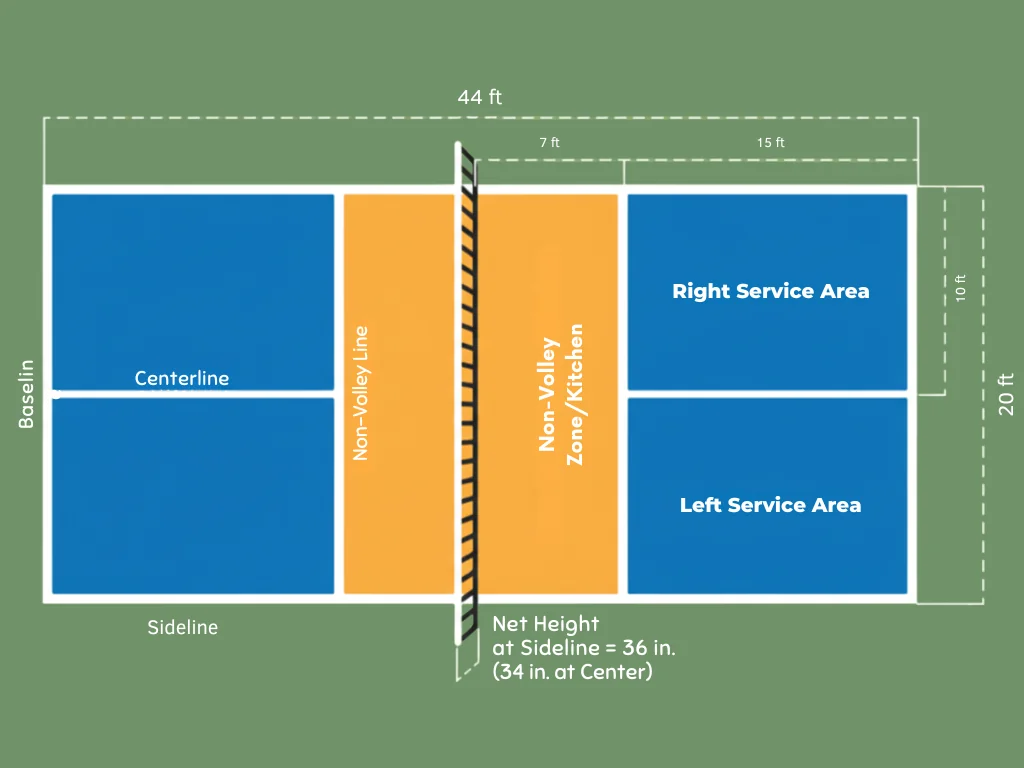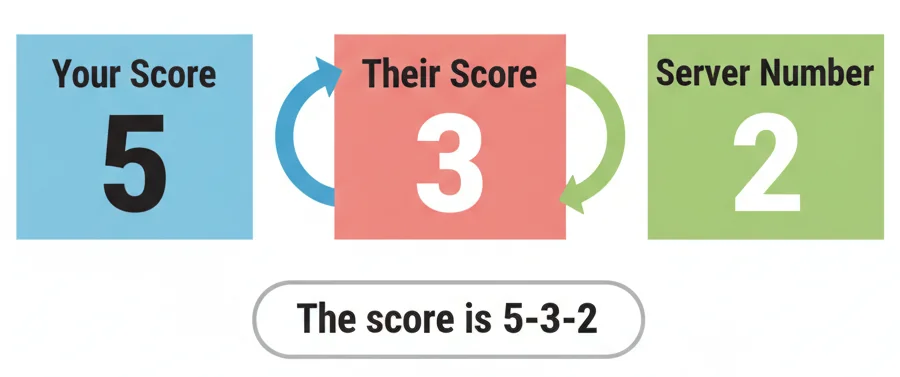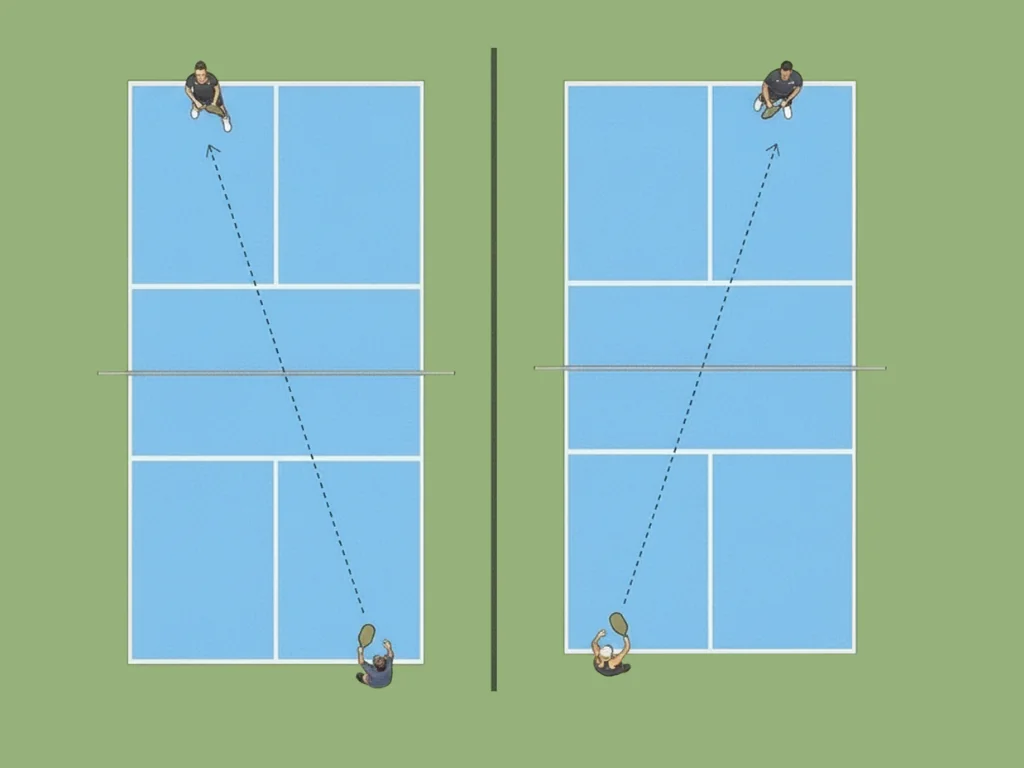Pickleball Rules: The Definitive Guide for 2025

Welcome to the most comprehensive and user-friendly guide to pickleball rules on the internet. Whether you're stepping onto the court for the first time or you're an experienced player looking to clarify a specific rule, you've come to the right place. Pickleball is fun and easy to learn, but knowing the rules is the key to confident play. In this guide, we'll break down everything from the absolute basics like serving and scoring to the nuances of the Non-Volley Zone. Let's dive in and master the rules of pickleball together!
What are the basic rules of pickleball?
The basic rules of pickleball involve serving underhand, cross-court, to start a rally. The ball must bounce once on each side (the double-bounce rule) before players can volley (hit it out of the air). Players cannot volley while standing in the 7-foot Non-Volley Zone, also known as 'the kitchen'. Points are scored only by the serving team when the opposing team commits a fault. Games are typically played to 11 points, win by 2.
In This Guide
- Understanding the Pickleball Court
- The 5 Unbreakable Rules of Pickleball (For Absolute Beginners)
- How Scoring Works in Pickleball: A Simple Guide
- Serving Rules: A Complete Breakdown
- The Kitchen & Non-Volley Zone Rules Explained
- The Double-Bounce Rule (or Two-Bounce Rule)
- Faults in Pickleball: How Rallies End
- Doubles vs. Singles Rules: Key Differences
- Ready to Play? Putting the Rules into Practice
Understanding the Pickleball Court
Before diving into the rules, let's get familiar with the playing area. A pickleball court is 44 feet long and 20 feet wide, the same size as a doubles badminton court. The court is divided by a net that is 36 inches high at the sidelines and 34 inches high in the middle. Here are the key areas to know:
- Baseline: The back line of the court where you stand to serve.
- Sidelines: The lines that mark the sides of the court.
- Non-Volley Zone (NVZ) or 'The Kitchen': The 7-foot area on both sides of the net. You cannot hit a volley while standing in this zone.
- Service Courts: The two boxes on each side of the court where the serve must land. The server serves cross-court to the diagonal service court.

A standard pickleball court is 44 feet long and 20 feet wide, with the Non-Volley Zone (Kitchen) extending 7 feet from the net on each side.
The 5 Unbreakable Rules of Pickleball (For Absolute Beginners)
If you only remember five things, make them these. These five basic pickleball rules govern 90% of the game and will get you playing in minutes.
- The Serve Must Be Underhand: The paddle must strike the ball below your waist in an upward motion. You must also have at least one foot behind the baseline when you serve.
- The Double-Bounce Rule: After the serve, the receiving team must let the ball bounce once before returning it. Then, the serving team must also let it bounce once before returning it. After these two bounces, players are free to volley the ball (hit it out of the air) or play it off the bounce.
- Stay Out of the Kitchen (When Volleying): The 7-foot area on either side of the net is the Non-Volley Zone (NVZ), or 'the kitchen'. You cannot hit a volley (a ball out of the air) while any part of your body is in the kitchen. You can step into the kitchen to hit a ball that has already bounced, but you must re-establish your feet outside the kitchen before you can hit a volley.
- Points Are Only Scored by the Serving Team: Just like in volleyball, you can only win a point when your team is serving. If you win a rally as the receiving team, you don't get a point—you just win the serve back.
- The Ball Must Stay In-Bounds: The lines are considered 'in'. A ball that lands on any line, except for the Non-Volley Zone line on the serve, is a good shot.
How Scoring Works in Pickleball: A Simple Guide
Scoring can be the most confusing part for new players. The key is to remember there are three numbers in the score announcement:
[Your Score] - [Opponent's Score] - [Server Number (1 or 2)]
- Server Number: In doubles, each player on a team gets a turn to serve before the serve goes to the other team. The server number indicates whether it's the first (1) or second (2) server's turn.
- Starting the Game: The game starts with the score
0-0-2. This is a unique rule. The first team to serve only gets one server (the 'second' server) for their first service turn to prevent them from having an unfair advantage. - Calling the Score: The server must always announce the score before serving. For example, if your team has 5 points, the opponents have 3, and you are the first server, you would call out, "Five-Three-One."
When your team scores a point, the same server switches to the other side of the court and serves again. You continue serving until you lose a rally. Then, the serve goes to your partner (server 2). Once your partner loses a rally, the serve goes to the other team (this is called a 'side out').

The score is always called in the same order: Your Score - Their Score - Your Server Number.
Serving Rules: A Complete Breakdown
The serve is how every point begins. Mastering the pickleball serving rules is fundamental to playing correctly. Here is a summary of the most critical elements.
- Motion: The serve must be an underhand motion. Your arm must be moving in an upward arc when you strike the ball.
- Contact Point: Paddle contact with the ball must happen below your navel.
- Paddle Head: The highest point of your paddle head cannot be above the highest part of your wrist at contact.
- Position: At least one foot must be behind the baseline, and you cannot touch the baseline or the court until after you've hit the ball.
- Direction: The serve must travel cross-court and land in the service box diagonal to you, beyond the non-volley zone line.
There are two main types of legal serves: the Volley Serve (hitting it out of the air) and the Drop Serve (dropping the ball and hitting it after the bounce). The Drop Serve is the simplest for beginners.
This is just a summary. For a complete explanation, including faults and let serves, check out our Definitive Guide to Pickleball Serving Rules.

A serve must be directed diagonally to the service court on the opposite side of the net.
USA Pickleball Rulebook 4.A.5
"The serve must be made with an underhand stroke so that contact with the ball is made below the waist. The arm must be moving in an upward arc and the highest point of the paddle head shall be below the highest part of the wrist..."
The Kitchen & Non-Volley Zone Rules Explained
The Non-Volley Zone (NVZ), or 'the kitchen', is the most unique feature of pickleball. It's the 7-foot area on each side of the net designed to prevent players from smashing the ball at close range.
The primary rule is simple: You cannot hit a volley while standing in the Non-Volley Zone.
A 'volley' is hitting the ball before it bounces. This includes not just your feet but anything you are wearing or carrying. If your momentum from a volley carries you into the kitchen, it is also a fault.
- When CAN you go in the kitchen? You are allowed to step into the kitchen at any time to hit a ball that has already bounced. You just need to re-establish both feet outside the kitchen before you are eligible to hit a volley again.
Understanding the kitchen is key to strategy. For more details on NVZ faults and tactics, read our Complete Guide to Kitchen Rules.
Common Mistake: The Momentum Fault
A very common fault is hitting a legal volley outside the kitchen, but your momentum causes your foot to step into the kitchen right after you hit the ball. This is a fault! You must have complete control of your body after a volley.
The Double-Bounce Rule (or Two-Bounce Rule)
This is another one of the foundational rules for pickleball that often confuses new players. It's actually quite simple when broken down:
- Bounce #1: The serve must bounce once on the receiver's side before they can hit it.
- Bounce #2: The return of serve must bounce once on the server's side before they can hit it.
That's it. After those first two bounces, the rule is 'off' for the rest of the rally, and players can either volley the ball or play it off a bounce. This rule prevents the serving team from rushing the net and smashing an easy winner, which encourages longer, more strategic rallies right from the start.

The ball must bounce once on the receiving side (1) and once on the serving side (2) before any player can volley.
Faults in Pickleball: How Rallies End
A rally is lost when one side commits a 'fault'. Understanding faults is key to understanding the pickleball game rules. A fault occurs when:
- You volley the ball from within the Non-Volley Zone.
- Your momentum carries you into the NVZ after a volley.
- You violate any of the serve rules.
- You violate the double-bounce rule.
- You hit the ball into the net.
- You hit the ball out of bounds.
- The ball bounces twice on your side of the court before you hit it.
- You or your paddle touch the net or the net posts while the ball is in play.
- The ball hits you or your clothing before you hit it back.
Doubles vs. Singles Rules: Key Differences
While most pickleball rules are the same for both doubles and singles, there are a few key differences, primarily in serving and scoring.
- Serving: In doubles, you serve until you and your partner both lose a rally (except on the first service of the game). In singles, you serve until you lose a rally, at which point the serve goes to your opponent (a 'side out').
- Scoring: In doubles, you call three numbers (5-3-1). In singles, you only call two: your score and the opponent's score (5-3). You don't need a server number because there's only one server.
- Server Position (Singles): Your position on the court when serving in singles depends on your score. If your score is even (0, 2, 4...), you serve from the right side of the court. If your score is odd (1, 3, 5...), you serve from the left side.
Ready to Play? Putting the Rules into Practice
Congratulations! You now have a solid understanding of the rules of pickleball. While reading is great, the best way to learn is to get out on the court and play. Don't be afraid to make mistakes—every player does. Call the score out loud, communicate with your partner, and most importantly, have fun.
This guide covers the core pickleball game rules, but remember to explore our more detailed articles on specific topics like scoring, serving, and kitchen strategy to truly elevate your game.
Can the pickleball serve land on the kitchen line?
No. If a serve lands on the Non-Volley Zone line (the 'kitchen line'), it is a fault. The serve must land beyond this line to be considered in.
What is a 'let' in pickleball?
A 'let' is a serve that hits the net but still lands in the correct service box. In pickleball, a let is a live ball and the rally continues. The receiver must play the ball. The old rule of replaying the serve was changed in 2021; you can follow all the latest pickleball rule changes here.
Can my paddle cross the plane of the net?
Yes, but only after you have struck the ball. You can follow through with your swing over the net, but you cannot cross the plane of the net to hit the ball on your opponent's side. The ball must cross to your side before you can legally hit it.
Printable Pickleball Rules Cheat Sheet
Download our free, one-page PDF summarizing the most important pickleball rules. Get the full breakdown on our printable cheat sheet page. Perfect for your court bag!
Download PDF